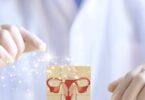Ovarian reserve, which reflects the pool of primordial follicles present in a woman’s ovaries, decreases with age. At the same time, researchers observe a decline of quality of the remaining oocytes.
Even though, unfortunately, the decline in follicle numbers cannot be reversed, improvement of oocyte quality is at the center of a lot of recent research.
To grasp the major importance of good oocyte quality, it is important to understand that the oocyte is a very large cell. It consists of a nucleus harboring the precious genetic information and a cytoplasm, which is responsible for its metabolism and energy production. We tend to talk a lot about the integrity of the DNA, which certainly is essential, but we must also not forget that the oocyte’s cytoplasm is equally important than its nucleus: As the embryo divides, each blastomere gets a smaller and smaller share of the oocyte’s cytoplasm. You see, the fetal genome does not become capable of adding cytoplasmic factors until the cleavage stage, and the oocyte’s remarkable cache of mitochondria (the cell’s “power plants”) do not again start to replicate until blastulation.
Research has made a lot of effort to tell us about factors that can have a negative impact on oocyte health. Among them are aging, oxidative stress, obesity, smoking, alcohol, and psychologic stress.
But can you actually improve it?
Experts more and more agree on the fact that oocyte quality can indeed (up to a certain level) be improved by a combination of certain lifestyle changes as well as supportive hormonal and orthomolecular therapy. A combination of these approaches can provide a healthy environment for the developing oocyte and can contribute to not only intact DNA, but also a cytoplasm with healthy metabolism and high energy yield.
References:
Meldrum DR, Casper RF, Diez-Juan A, Simon C, Domar AD, Frydman R.
Aging and the environment affect gamete and embryo potential: can we intervene? Fertil Steril. 2016 Mar;105(3):548-559. doi: 10.1016/j.fertnstert.2016.01.013. Epub 2016 Jan 23.
David R. Meldrum, M.D. Introduction: Examining the many potential reasons why euploid blastocysts do not always result in viable pregnancies: part 1 2016; Volume 105, Issue 3, Pages 545–547







